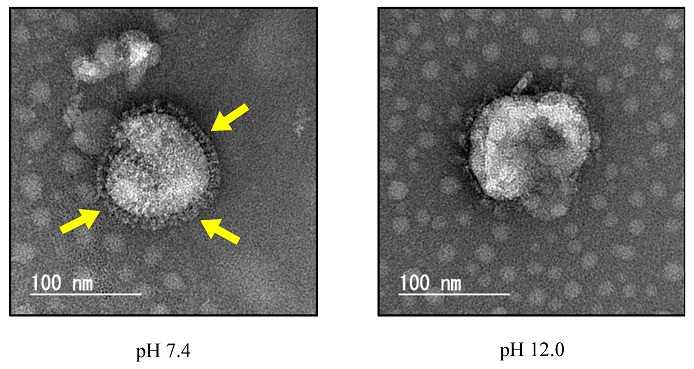Nikhil Prasad Fact checked by:Thailand Medical News Team Oct 22, 2024 5 months, 3 weeks, 20 hours, 30 minutes ago
Medical News: Influenza A virus (IAV) remains a major public health threat worldwide, contributing to hundreds of thousands of deaths each year. Despite various preventive measures, such as vaccination and the use of alcohol-based disinfectants, the fight against IAV remains challenging. However, researchers from Chubu University in Japan have recently discovered a promising alternative: the use of alkaline solutions to inactivate IAV. This new method could significantly change how we combat the virus, especially in environments where alcohol-based disinfectants are less effective or undesirable.
 New Approach for Inactivating Influenza A Virus Using Alkaline Solutions
New Approach for Inactivating Influenza A Virus Using Alkaline Solutions
IAV particles treated with alkaline solutions were negatively stained and images were obtained using transmission electron microscopy. Yellow indicates viral spikes. Data are representative of two independent experiments.
Alcohol Disinfectants: Are They Enough?
Alcohol-based disinfectants are commonly used to kill the influenza virus, both on surfaces and for hand sanitization. However, they come with several downsides. Studies have shown that alcohol-based disinfectants can cause dermatological issues in nearly half of the users and can lead to psychological discomfort due to stress and skin irritation. Additionally, there are concerns that alcohol-based solutions may not always be the safest option for frequent use.
In search of alternative methods, scientists turned to the potential of alkaline solutions. The effect of pH on the structure and infectivity of viruses has been studied in the past, primarily focusing on acidic environments. However, this
Medical News report will explore a recent study that delves into how alkaline conditions can be used to deactivate the influenza A virus effectively.
The Study: How Alkaline Solutions Work
The research team from Chubu University, Japan, including scientists from various departments such as the Graduate School of Life and Health Sciences and the Department of Food and Nutritional Sciences, conducted a detailed study on how alkaline solutions can impact the structure and function of the influenza virus. Their goal was to find a safer, more reliable method to inactivate the virus that does not rely on alcohol.
The research specifically focused on the hemagglutinin (HA) protein, a key structural protein of the influenza virus that plays a crucial role in its infectivity. HA binds to receptors on the surface of host cells, enabling the virus to enter and infect the host. This protein's stability and function are highly dependent on environmental conditions such as pH.
Key Findings: Alkaline Conditions Are Highly Effective
The researchers exposed the influenza virus to alkaline solutions with varying pH levels, ranging from pH 10.0 to 12.0. The results were astonishing. While the virus remained relatively unaffected at pH levels below 11.75, once the pH reached 12.0, the infectivity of the virus decreased dramatically. Within
just one minute of exposure to pH 12.0, the virus's ability to infect cells was reduced by more than three orders of magnitude.
Further analysis using electron microscopy revealed that at these high pH levels, the viral structure, particularly the hemagglutinin spikes, began to degrade. The hemagglutinin proteins that normally protrude from the virus’s surface were no longer visible after treatment with the pH 12.0 solution. This destruction of viral spikes directly corresponded with the virus losing its ability to infect host cells.
Additionally, Western blot analysis showed that the HA proteins were severely affected by the alkaline treatment. The hemagglutinin precursor, HA0, typically cleaves into two subunits, HA1 and HA2, during the infection process. However, after being exposed to the alkaline solution, the HA1 + HA2 complex was disrupted, and the amount of HA2 increased. This indicated that the inter-subunit disulfide bonds were broken, leading to the degradation of the hemagglutinin protein. Without these critical proteins, the virus was no longer able to bind to host cells, rendering it inactive.
Wider Implications: Beyond Just Influenza
The researchers also suggested that alkaline solutions could potentially be used against other enveloped viruses that rely on spike proteins for infection. This opens up new avenues for disinfecting environments and surfaces, particularly in healthcare settings where the spread of viruses like IAV is a significant concern.
Moreover, it’s worth noting that the alkaline solution used in this study was much milder than typical household cleaners, reducing concerns about skin irritation or toxicity. In fact, the study pointed out that human skin has a natural buffering capacity that can neutralize high pH levels within a short period, minimizing the risk of adverse effects.
Why Alkaline Solutions Could Be a Game Changer
The use of alkaline solutions as a disinfectant presents several advantages. Firstly, they are highly effective at inactivating IAV within a short time, making them suitable for quick disinfection of surfaces and hands. Secondly, they avoid many of the problems associated with alcohol-based disinfectants, such as skin irritation. Lastly, alkaline solutions could offer a new approach in environments where alcohol disinfectants are impractical or ineffective.
This new method could especially benefit healthcare settings, public places, and households during the flu season, helping reduce the transmission of the virus.
Conclusion: The Future of Influenza Control
In conclusion, the study conducted by Chubu University highlights the potential of using alkaline solutions to combat the influenza A virus. By degrading the virus's structural proteins, particularly hemagglutinin, these solutions effectively inactivate the virus within just a minute of exposure. The findings suggest that alkaline solutions could be a safer and equally effective alternative to alcohol-based disinfectants, with broader applications in fighting other enveloped viruses.
The study findings were published in the peer-reviewed journal: Viruses.
https://www.mdpi.com/1999-4915/16/10/1636
For the latest on Influenza, keep on logging into Thailand
Medical News.
Read Also:
https://www.thailandmedical.news/news/how-gut-microbiota-could-unlock-new-treatments-for-influenza
https://www.thailandmedical.news/news/korean-researchers-find-that-the-herb-angelica-tenuissima-nakai-shows-promise-in-fighting-influenza-a
